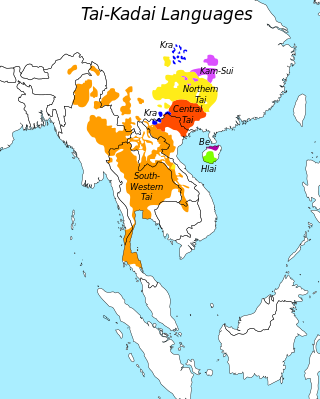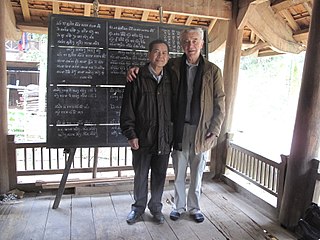
Sino-Tibetan, also cited as Trans-Himalayan in a few sources, is a family of more than 400 languages, second only to Indo-European in number of native speakers. The vast majority of these are the 1.3 billion native speakers of Chinese languages. Other Sino-Tibetan languages with large numbers of speakers include Burmese and the Tibetic languages. Other languages of the family are spoken in the Himalayas, the Southeast Asian Massif, and the eastern edge of the Tibetan Plateau. Most of these have small speech communities in remote mountain areas, and as such are poorly documented.

The Kra–Dai languages are a language family in Mainland Southeast Asia, Southern China and Northeast India. All languages in the family are tonal languages, including Thai and Lao, the national languages of Thailand and Laos respectively. Around 93 million people speak Kra–Dai languages, 60% of whom speak Thai. Ethnologue lists 95 languages in the family, with 62 of these being in the Tai branch.
In linguistics, mirativity, initially proposed by Scott DeLancey, is a grammatical category in a language, independent of evidentiality, that encodes the speaker's surprise or the unpreparedness of their mind. Grammatical elements that encode the semantic category of mirativity are called miratives.
Southern Qiang is a Sino-Tibetan language of the Qiangic branch spoken by approximately 81,300 people along the Minjiang river in Sichuan Province, China.
Naxi, also known as Nakhi, Nasi, Lomi, Moso, Mo-su, is a Sino-Tibetan language or group of languages spoken by some 310,000 people, most of whom live in or around Lijiang City Yulong Naxi Autonomous County of the province of Yunnan, China. Nakhi is also the ethnic group that speaks it, although in detail, officially defined ethnicity and linguistic reality do not coincide neatly: there are speakers of Naxi who are not registered as "Naxi" and citizens who are officially "Naxi" but do not speak it.
Bodish, named for the Tibetan ethnonym Bod, is a proposed grouping consisting of the Tibetic languages and associated Sino-Tibetan languages spoken in Tibet, North India, Nepal, Bhutan, and North Pakistan. It has not been demonstrated that all these languages form a clade, characterized by shared innovations, within Sino-Tibetan.
The Nung or Nungish languages are a poorly described family of uncertain affiliation within the Sino-Tibetan languages spoken in Yunnan, China and Burma. They include:
Gong Hwang-cherng (1934–2010) was a Taiwanese linguist who specialized in Sino-Tibetan comparative linguistics and the phonetic reconstruction of Tangut and Old Chinese.

The Tibeto-Burman languages are the non-Sinitic members of the Sino-Tibetan language family, over 400 of which are spoken throughout the Southeast Asian Massif ("Zomia") as well as parts of East Asia and South Asia. Around 60 million people speak Tibeto-Burman languages. The name derives from the most widely spoken of these languages, Burmese and the Tibetic languages, which also have extensive literary traditions, dating from the 12th and 7th centuries respectively. Most of the other languages are spoken by much smaller communities, and many of them have not been described in detail.
Laurent Sagart is a senior researcher at the Centre de recherches linguistiques sur l'Asie orientale unit of the Centre National de la Recherche Scientifique (CNRS).

Guillaume Jacques is a French linguist who specializes in the study of Sino-Tibetan languages: Old Chinese, Tangut, Tibetan, Gyalrongic and Kiranti languages. He also performs research on the Algonquian and Siouan language families, and publishes about languages of other families such as Breton. His case studies in historical phonology are set in the framework of panchronic phonology, aiming to formulate generalizations about sound change that are independent of any particular language or language group.
Proto-Tibeto-Burman is the reconstructed ancestor of the Tibeto-Burman languages, that is, the Sino-Tibetan languages, except for Chinese. An initial reconstruction was produced by Paul K. Benedict and since refined by James Matisoff. Several other researchers argue that the Tibeto-Burman languages sans Chinese do not constitute a monophyletic group within Sino-Tibetan, and therefore that Proto-Tibeto-Burman was the same language as Proto-Sino-Tibetan.
Old Tibetan refers to the period of Tibetan language reflected in documents from the adoption of writing by the Tibetan Empire in the mid-7th century to works of the early 11th century.
William Hubbard Baxter III is an American linguist specializing in the history of the Chinese language and best known for his work on the reconstruction on Old Chinese.
Scott DeLancey is an American linguist from the University of Oregon. His work focuses on typology and historical linguistics of Tibeto-Burman languages as well as North American indigenous languages such as the Penutian family, particularly the Klamath. His research is known for its diversity of its thematic and theoretical reach.

Michel Ferlus is a French linguist whose special study is in the historical phonology of languages of Southeast Asia. In addition to phonological systems, he also studies writing systems, in particular the evolution of Indic scripts in Southeast Asia.

Alexis Michaud is a French linguist specialising in the study of Southeast Asian languages, especially Naic languages and Vietnamese. He is also known for his work on the typology of tonal languages and as a foremost proponent of Panchronic phonology. He is one of the main editors of the Pangloss Collection. He works at the LACITO research centre within Centre National de la Recherche Scientifique.
Cahiers de Linguistique Asie Orientale is a peer-reviewed academic journal of East Asian linguistics that was established in 1978 and is published by Brill. The articles published before 2007 are in free access on the Persée website.
Mruic or Mru–Hkongso is a small group of Sino-Tibetan languages consisting of two poorly attested languages, Mru and Anu-Hkongso. Their relationship within Sino-Tibetan is unclear.
Proto-Kra–Dai is the proposed reconstructed ancestor of the Kra–Dai languages.






